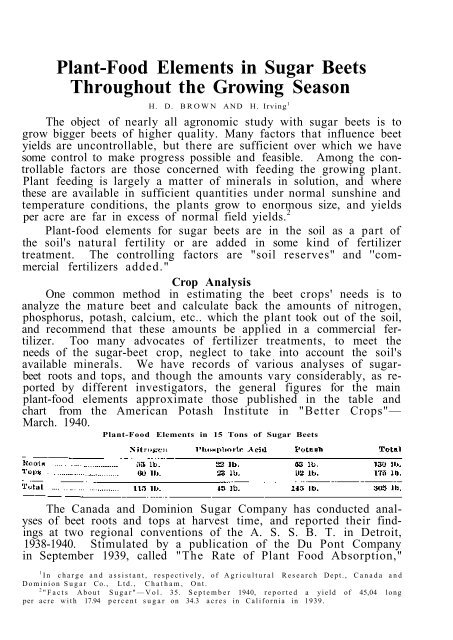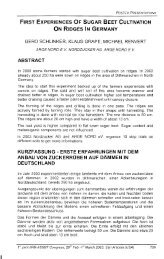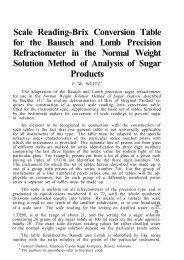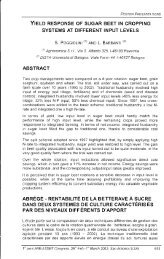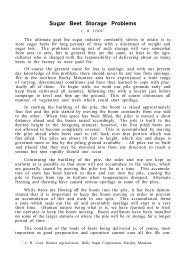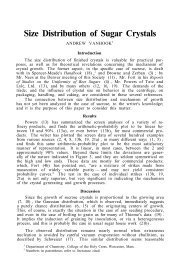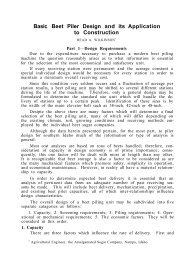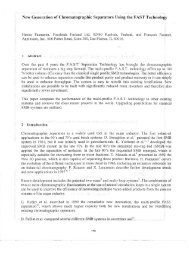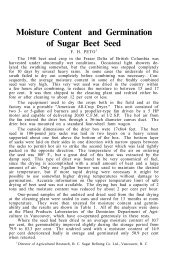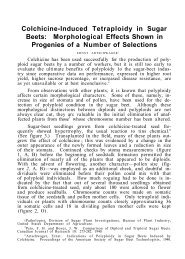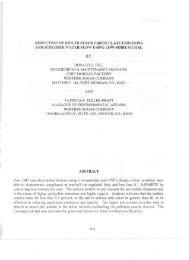Plant-Food Elements in Sugar Beets Throughout the Growing Season
Plant-Food Elements in Sugar Beets Throughout the Growing Season
Plant-Food Elements in Sugar Beets Throughout the Growing Season
You also want an ePaper? Increase the reach of your titles
YUMPU automatically turns print PDFs into web optimized ePapers that Google loves.
<strong>Plant</strong>-<strong>Food</strong> <strong>Elements</strong> <strong>in</strong> <strong>Sugar</strong> <strong>Beets</strong><br />
<strong>Throughout</strong> <strong>the</strong> Grow<strong>in</strong>g <strong>Season</strong><br />
H. D. BROWN AND H. Irv<strong>in</strong>g 1<br />
The object of nearly all agronomic study with sugar beets is to<br />
grow bigger beets of higher quality. Many factors that <strong>in</strong>fluence beet<br />
yields are uncontrollable, but <strong>the</strong>re are sufficient over which we have<br />
some control to make progress possible and feasible. Among <strong>the</strong> controllable<br />
factors are those concerned with feed<strong>in</strong>g <strong>the</strong> grow<strong>in</strong>g plant.<br />
<strong>Plant</strong> feed<strong>in</strong>g is largely a matter of m<strong>in</strong>erals <strong>in</strong> solution, and where<br />
<strong>the</strong>se are available <strong>in</strong> sufficient quantities under normal sunsh<strong>in</strong>e and<br />
temperature conditions, <strong>the</strong> plants grow to enormous size, and yields<br />
per acre are far <strong>in</strong> excess of normal field yields. 2<br />
<strong>Plant</strong>-food elements for sugar beets are <strong>in</strong> <strong>the</strong> soil as a part of<br />
<strong>the</strong> soil's natural fertility or are added <strong>in</strong> some k<strong>in</strong>d of fertilizer<br />
treatment. The controll<strong>in</strong>g factors are "soil reserves" and ''commercial<br />
fertilizers added."<br />
Crop Analysis<br />
One common method <strong>in</strong> estimat<strong>in</strong>g <strong>the</strong> beet crops' needs is to<br />
analyze <strong>the</strong> mature beet and calculate back <strong>the</strong> amounts of nitrogen,<br />
phosphorus, potash, calcium, etc.. which <strong>the</strong> plant took out of <strong>the</strong> soil,<br />
and recommend that <strong>the</strong>se amounts be applied <strong>in</strong> a commercial fertilizer.<br />
Too many advocates of fertilizer treatments, to meet <strong>the</strong><br />
needs of <strong>the</strong> sugar-beet crop, neglect to take <strong>in</strong>to account <strong>the</strong> soil's<br />
available m<strong>in</strong>erals. We have records of various analyses of sugarbeet<br />
roots and tops, and though <strong>the</strong> amounts vary considerably, as reported<br />
by different <strong>in</strong>vestigators, <strong>the</strong> general figures for <strong>the</strong> ma<strong>in</strong><br />
plant-food elements approximate those published <strong>in</strong> <strong>the</strong> table and<br />
chart from <strong>the</strong> American Potash Institute <strong>in</strong> "Better Crops"—<br />
March. 1940.<br />
<strong>Plant</strong>-<strong>Food</strong> <strong>Elements</strong> <strong>in</strong> 15 Tons of <strong>Sugar</strong> <strong>Beets</strong><br />
The Canada and Dom<strong>in</strong>ion <strong>Sugar</strong> Company has conducted analyses<br />
of beet roots and tops at harvest time, and reported <strong>the</strong>ir f<strong>in</strong>d<strong>in</strong>gs<br />
at two regional conventions of <strong>the</strong> A. S. S. B. T. <strong>in</strong> Detroit,<br />
1938-1940. Stimulated by a publication of <strong>the</strong> Du Pont Company<br />
<strong>in</strong> September 1939, called "The Rate of <strong>Plant</strong> <strong>Food</strong> Absorption,"<br />
1 In charge and assistant, respectively, of Agricultural Research Dept., Canada and<br />
Dom<strong>in</strong>ion <strong>Sugar</strong> Co., Ltd., Chatham, Ont.<br />
2 "Facts About <strong>Sugar</strong>"—Vol. 35. September 1940, reported a yield of 45,04 long<br />
per acre with 17.94 percent sugar on 34.3 acres <strong>in</strong> California <strong>in</strong> 1939.
90 AMERICAN - SOCIETY SUGAR-BEET TECHNOLOGISTS<br />
we undertook an <strong>in</strong>troductory study of this subject for sugar beets.<br />
The publication <strong>in</strong> question dealt only with tomatoes, potatoes, corn<br />
and tobacco, draw<strong>in</strong>g upon experimental data from various American<br />
journals, and experiment station reports.<br />
Object<br />
In this study our object was to ga<strong>in</strong> fur<strong>the</strong>r <strong>in</strong>formation on feed<strong>in</strong>g<br />
sugar beets, from analyses of sugar beets at various stages of<br />
growth. It was an attempt to see what is <strong>in</strong> <strong>the</strong> average sugar-beet<br />
plant at "various stages" <strong>in</strong> order to get some <strong>in</strong>dication of <strong>the</strong> rate<br />
of plant-food absorption dur<strong>in</strong>g <strong>the</strong> grow<strong>in</strong>g season.<br />
Plan<br />
The plan was to utilize sugar-beet plants grow<strong>in</strong>g under normal<br />
Ontario conditions and select random samples whose analyses would<br />
<strong>in</strong>dicate <strong>the</strong> plant-food elements taken <strong>in</strong> by <strong>the</strong> plants up to that<br />
particular stage of growth.<br />
A commercial field <strong>in</strong> each of our factory areas was used and<br />
samples taken at about 3-week <strong>in</strong>tervals. In <strong>the</strong> early stages of<br />
growth a def<strong>in</strong>ite length of row was taken and <strong>the</strong> data calculated<br />
on an acre basis. When <strong>the</strong> beets were of sufficient size, a def<strong>in</strong>ite<br />
number of beets were taken and correlated with average stand and<br />
yield per acre. The data were <strong>the</strong>n calculated back to a l5-tons-peracre<br />
crop.<br />
Roots and tops were weighed and analyzed separately at each<br />
of 7 stages of development. The items <strong>in</strong>vestigated were fresh and<br />
dry weights, nitrogen, phosphoric acid, potash and calcium.<br />
Photographs were taken of <strong>the</strong> beet plants at each of <strong>the</strong> 7 stages<br />
analyzed. and cover <strong>the</strong> normal grow<strong>in</strong>g period of 170 days <strong>in</strong> Ontario.<br />
Methods<br />
Fresh weights were taken of tared beets and tops as soon as<br />
lifted <strong>in</strong> <strong>the</strong> field and dry weights were obta<strong>in</strong>ed after chopp<strong>in</strong>g and<br />
dry<strong>in</strong>g <strong>in</strong> an electric oven at 65º C.<br />
Ash<strong>in</strong>g and preparation of 1 he solution for analysis for P 2 O 5 ,<br />
K 2 O and CaO were made by method of C. F. Rivas, published <strong>in</strong><br />
"Scientific Agriculture," Vol. 19, No. 4, 1938.<br />
Analyses for nitrogen, P 2 O 5 , CaO and K 2 O were made by <strong>the</strong><br />
A. O. A. C. methods, 1940 edition.<br />
Results<br />
The analytical results of <strong>the</strong>se samples, made <strong>in</strong> duplicate, were<br />
averaged for two experimental fields, one a Clyde clay and <strong>the</strong> o<strong>the</strong>r<br />
a Thames clay loam. S<strong>in</strong>ce it was impossible to analyze <strong>the</strong> same<br />
beets throughout <strong>the</strong> grow<strong>in</strong>g season, <strong>the</strong>re is considerable variation<br />
<strong>in</strong> <strong>the</strong> contents found. The stages of growth, however, were dist<strong>in</strong>ct<br />
and show <strong>the</strong> relative composition of <strong>the</strong> sugar beets at approximately<br />
3-week <strong>in</strong>tervals.
<strong>Sugar</strong> beets at 7 growth stages: Stage 1, June 6—26 days; 2, June 26—46 days;<br />
3. July 11—66 days; 4. August 12—93 days ; 5, August 29—110 days; 6, September 25—<br />
137 days; 7, October 25—167 days.
92 AMERICAN SOCIETY SUGAR-BEET TECHNOLOGISTS<br />
Data<br />
The data are presented <strong>in</strong> 5 tables. Table I gives <strong>the</strong> fresh and<br />
dry weights of tops and roots at each of <strong>the</strong> 7 stages for which <strong>the</strong><br />
length of grow<strong>in</strong>g season and date are given.<br />
Tables II to V, <strong>in</strong>clusive, show <strong>the</strong> content of sugar beets at each<br />
stage, <strong>in</strong> terms of <strong>the</strong> pounds of nitrogen, phosphate, potash, and calcium<br />
<strong>in</strong> <strong>the</strong> roots and tops, with <strong>in</strong>crements between stages.<br />
The tables are paralleled with histograms which show graphically<br />
<strong>the</strong> amount of each plant-food element <strong>in</strong> root, top, and total plant<br />
at each of <strong>the</strong> stages <strong>in</strong>vestigated.<br />
Table I.—Fresh and Dry Weights of <strong>Beets</strong> at Various Stages of Growth<br />
(In tons per acre based upon harvested weight of 15 tons per acre)<br />
Table II.—Nitrogen (N) <strong>in</strong> <strong>Sugar</strong> <strong>Beets</strong> at Various Stages of Growth<br />
(In pounds per acre for roots and tops with <strong>in</strong>crements by stages)
PROCEEDINGS—THIRD GENERAL MEETING<br />
93<br />
Table III.—Phosphate (P2O5) <strong>in</strong> <strong>Sugar</strong> <strong>Beets</strong> at Various Stages of Growth<br />
(In pounds per acre for roots and tops with <strong>in</strong>crements by stages)<br />
Table IV.--Potash (K2O) <strong>in</strong> <strong>Sugar</strong> <strong>Beets</strong> at Various Stages of Growth<br />
(In pounds per acre for roots and tops with <strong>in</strong>crements by stages)<br />
Table V.—Calcium (CaO) <strong>in</strong> <strong>Sugar</strong> <strong>Beets</strong> at Various Stages of Growth<br />
(In pounds per acre for roots and tops with <strong>in</strong>crements by stages)
94 AMERICAN SOCIETY SUGAR-BEET TECHNOLOGISTS<br />
Discussion of Results<br />
Fresh Weights.—When <strong>the</strong> sugar-beet weights are plotted<br />
aga<strong>in</strong>st stages of growth <strong>the</strong> l<strong>in</strong>e connect<strong>in</strong>g <strong>the</strong>se po<strong>in</strong>ts shows a<br />
close approximation to <strong>the</strong> growth curve of Mitscherlik (1). The<br />
early stages of growth were characterized by a slowly <strong>in</strong>creas<strong>in</strong>g rate<br />
which became a maximum <strong>in</strong> July and August. Harvest <strong>in</strong> late October<br />
apparently cut <strong>in</strong>to <strong>the</strong> slacken<strong>in</strong>g off of growth rate, which<br />
normally follows a sigmoid curve.<br />
The sugar-beet roots weighed less than <strong>the</strong> tops at each of <strong>the</strong><br />
stages until mid-August, but root growth was accelerated from <strong>the</strong>n<br />
on so that <strong>the</strong> roots were 26 percent heavier than <strong>the</strong> tops at harvest<br />
time. The root weight of 15.00 tons per acre had a crown and top<br />
weight of 11.83 tons after 167 days of growth.<br />
Dry Weights.—In <strong>the</strong> first stages of growth, sugar beets have a<br />
very low dry-matter content. The analyses at different stages showed<br />
an <strong>in</strong>creas<strong>in</strong>g percentage of dry matter, which <strong>in</strong> roots rose from<br />
12 to 20 percent, and <strong>in</strong> tops from 6 to 16 percent dur<strong>in</strong>g <strong>the</strong> 7 stages<br />
of analysis. The l5-tons-per-acrc crop of beets at harvest time conta<strong>in</strong>ed<br />
3.038 tons of dry matter <strong>in</strong> <strong>the</strong> roots and 1.789 tons of dry<br />
matter <strong>in</strong> <strong>the</strong> tops, as seen <strong>in</strong> table I. The graph below shows <strong>the</strong> drymatter<br />
stages approach<strong>in</strong>g a normal growth curve <strong>in</strong> a more depressed<br />
form than those of <strong>the</strong> fresh material.<br />
FRESH AND DRY WEIGHTS OF BEETS AT VARIOUS STAGES OF GROWTH
PROCEEDINGS—THIRD GENERAL MEETING 95<br />
Nitrogen.—Nitrogen was <strong>the</strong> second largest plant-food element<br />
<strong>in</strong> <strong>the</strong> sugar beets, with 141.9 pounds per acre at harvest time. The<br />
tops conta<strong>in</strong>ed more than half of <strong>the</strong> total nitrogen at every stage,<br />
but <strong>the</strong> root-conta<strong>in</strong>ed nitrogen <strong>in</strong>creased proportionately, as root development<br />
was rapid dur<strong>in</strong>g <strong>the</strong> later stages of growth. At stage 7,<br />
<strong>in</strong> October, <strong>the</strong> roots conta<strong>in</strong>ed 66.0 pounds and <strong>the</strong> tops 75.9 pounds<br />
of nitrogen.<br />
The nitrogen content of tops, <strong>in</strong> percentage of dry matter, was<br />
almost double that of <strong>the</strong> roots at all stages, but <strong>in</strong> both roots and<br />
tops, <strong>the</strong> nitrogen percentage of dry matter dropped at later stages,<br />
so that <strong>in</strong> stage 7, at harvest, it was only half of what it had been<br />
at stage 1, near th<strong>in</strong>n<strong>in</strong>g time. Thus, an <strong>in</strong>itial nitrogen content of<br />
2.95 percent <strong>in</strong> <strong>the</strong> roots and 4.07 percent <strong>in</strong> <strong>the</strong> tops had decreased<br />
to 1.04 percent <strong>in</strong> <strong>the</strong> roots and 2.12 percent <strong>in</strong> <strong>the</strong> tops, at harvest.<br />
The nitrogen content of beets exceeded <strong>the</strong> potash content <strong>in</strong><br />
July, but was relatively less at earlier and later stages. The data<br />
would <strong>in</strong>dicate a need of sugar beets for available nitrogen <strong>in</strong> <strong>in</strong>creas<strong>in</strong>g<br />
amounts as <strong>the</strong> grow<strong>in</strong>g season progresses and a build-up of<br />
nitrogen <strong>in</strong> <strong>the</strong> plant especially dur<strong>in</strong>g <strong>the</strong> rapid grow<strong>in</strong>g period.<br />
Phosphate.—Although <strong>the</strong> total amount of phosphate found <strong>in</strong><br />
sugar beets at any stage of growth is relatively small compared to<br />
nitrogen or potash, it is utilized at all stages of growth, and totalled<br />
42.6 pounds <strong>in</strong> a 15-tons-per-acre crop. About 60 percent of <strong>the</strong><br />
phosphate was <strong>in</strong> <strong>the</strong> roots <strong>in</strong> <strong>the</strong> October stage, but this larger proportion<br />
was only atta<strong>in</strong>ed <strong>in</strong> <strong>the</strong> later stages when root growth was dom<strong>in</strong>ant<br />
over top growth.<br />
On a dry-matter basis, phosphate was slightly over 1 percent <strong>in</strong><br />
<strong>the</strong> pre-th<strong>in</strong>n<strong>in</strong>g stage and decreased <strong>in</strong> proportion, <strong>in</strong> both root and<br />
top. until harvest time when it was under 0.5 percent of <strong>the</strong> total dry<br />
matter. Never<strong>the</strong>less, phosphate was taken up by <strong>the</strong> tops and roots<br />
<strong>in</strong> <strong>in</strong>creas<strong>in</strong>g amounts all through <strong>the</strong> season except <strong>in</strong> <strong>the</strong> f<strong>in</strong>al stage<br />
when <strong>the</strong> tops were partially decimated by Oercospora. In <strong>the</strong> roots.<br />
<strong>the</strong> greatest <strong>in</strong>crement of phosphate was <strong>in</strong> <strong>the</strong> f<strong>in</strong>al stage of growth.<br />
Phosphate should be available to <strong>the</strong> beet plant all through <strong>the</strong> grow<strong>in</strong>g<br />
season, and be present <strong>in</strong> larger quantities toward <strong>the</strong> end of <strong>the</strong><br />
growth period when it apparently plays a part <strong>in</strong> <strong>the</strong> maturity and<br />
keep<strong>in</strong>g quality of <strong>the</strong> beets.<br />
Potash.—Among <strong>the</strong> plant-food elements found <strong>in</strong> sugar beets,<br />
potash ranks highest both <strong>in</strong> percentage of dry matter and <strong>in</strong> total<br />
weight of plant. In <strong>the</strong> 15-tons-per-acre crop at harvest, <strong>the</strong> potash<br />
totalled 180.2 pounds, of which 105.8 pounds were <strong>in</strong> <strong>the</strong> roots and<br />
74.4 pounds <strong>in</strong> <strong>the</strong> tops.
96 AMERICAN SOCIETY SUGAR-BEET TECHNOLOGISTS<br />
HISTOGRAMS SHOWING INCREMENTS OF NITROGEN, PHOSPHATE, POTASH.<br />
AND CALCIUM BETWEEN STAGES OF GROWTH OF SUGAR BEETS
PROCEEDINGS—THIRD GENERAL MEETING 97<br />
CALCIUM (C 2O) IN SUGAR-BEET ROOTS AND TOPS<br />
( IN POUNDS PER ACRE AT 7 STA6ES OF GROWTH )<br />
In <strong>the</strong>se analyses <strong>the</strong> potash, at all stages of growth, was very<br />
high <strong>in</strong> terms of dry matter, be<strong>in</strong>g over 8 percent <strong>in</strong> <strong>the</strong> seedl<strong>in</strong>g<br />
roots and nearly 6 percent <strong>in</strong> <strong>the</strong> seedl<strong>in</strong>g tops. Although <strong>the</strong> percentages,<br />
<strong>in</strong> terms of dry matter, were lower <strong>in</strong> later stages, <strong>the</strong> tops<br />
still conta<strong>in</strong>ed over 3 percent potash at stage 6.<br />
Potash <strong>in</strong>crements were large at every stage of growth and<br />
greater than those of any o<strong>the</strong>r element for <strong>the</strong> same period. The<br />
dra<strong>in</strong> on soil potash was particularly high for <strong>the</strong> tops after <strong>the</strong> middle<br />
of July and cont<strong>in</strong>ued up to harvest though <strong>the</strong> last period fell<br />
off a little, probably due to Cercospora effect on <strong>the</strong> leaf tissue. The<br />
largest call for potash <strong>in</strong> <strong>the</strong> roots was <strong>in</strong> September and October.<br />
The soils used for <strong>the</strong> sugar beets <strong>in</strong> this experiment are well<br />
supplied with potash reserves, as seen <strong>in</strong> <strong>the</strong> analyses presented below.<br />
However, <strong>the</strong> needs of <strong>the</strong> plant are so groat that adequate supplies<br />
must be assured <strong>the</strong> beets throughout <strong>the</strong> grow<strong>in</strong>g season. Soil<br />
analyses should go hand <strong>in</strong> hand with fertilizer analyses and give<br />
particular attention to potash.<br />
Calcium.—Calcium is important to <strong>the</strong> sugar beet, not only <strong>in</strong><br />
its role of giv<strong>in</strong>g a favorable soil reaction, but as an element of <strong>the</strong><br />
plant itself. There were larger amounts of calcium present <strong>in</strong> <strong>the</strong><br />
beets at all stages than phosphate and <strong>the</strong> 15-tons-per-acre crop at<br />
harvest conta<strong>in</strong>ed 22.0 pounds of CaO <strong>in</strong> <strong>the</strong> roots and 49.5 pounds<br />
<strong>in</strong> <strong>the</strong> tops, a total of 71.5 pounds per acre of beets.<br />
The beet seedl<strong>in</strong>gs conta<strong>in</strong>ed almost 1 percent of calcium <strong>in</strong> <strong>the</strong><br />
dry matter of <strong>the</strong> roots and 1.6 percent <strong>in</strong> <strong>the</strong> tops. In dry matter at
98 AMERICAN SOCIETY SUGAR-BEET TECHNOLOGISTS<br />
subsequent stages <strong>the</strong> root percentages were down below 0.5 percent<br />
but <strong>in</strong> <strong>the</strong> tops <strong>the</strong> percentages stayed well above 1 percent at all<br />
stages, <strong>the</strong>reby conta<strong>in</strong><strong>in</strong>g nearly 50 pounds <strong>in</strong> sugar-beet tops at<br />
harvest time. Calcium is needed by <strong>the</strong> beet at all stages of growth<br />
and is taken <strong>in</strong> steadily throughout <strong>the</strong> grow<strong>in</strong>g season.<br />
Magnesium.—S<strong>in</strong>ce sugar beets normally conta<strong>in</strong> a considerable<br />
amount of magnesium, <strong>the</strong> contents of sugar beets at each stage <strong>in</strong> one<br />
series of samples were taken. Due to <strong>in</strong>completeness of <strong>the</strong> data,<br />
<strong>the</strong>y were not <strong>in</strong>cluded <strong>in</strong> <strong>the</strong> tables, but paralleled <strong>the</strong> calcium contents<br />
to quite a degree. The magnesium content of tops was higher<br />
than <strong>the</strong> magnesium content of roots and was above 1 percent of<br />
<strong>the</strong> dry-matter weight of tops throughout most of <strong>the</strong> grow<strong>in</strong>g season.<br />
Though not as high a percentage <strong>in</strong> <strong>the</strong> roots as <strong>in</strong> <strong>the</strong> tops, <strong>the</strong>re<br />
was always a considerable amount of magnesium present and it was<br />
taken up by <strong>the</strong> plant all through <strong>the</strong> grow<strong>in</strong>g period.<br />
Soil Analysis<br />
The soil type and available plant-food elements are important<br />
<strong>in</strong> <strong>the</strong> study of sugar-beet contents and <strong>in</strong> any plan to <strong>in</strong>crease production<br />
levels. Fur<strong>the</strong>r <strong>in</strong>vestigation may prove that <strong>the</strong> soil content<br />
of plant-food elements has much to do with <strong>the</strong> plant contents.<br />
The beets used for this <strong>in</strong>vestigation were taken from a series of<br />
plots on a Clyde clay and a series on Thames clay loam. Both soils
PROCEEDINGS—THIRD GENERAL, MEETING 99<br />
Lb.<br />
50' .<br />
PHOSPHATE (P 20 5) IN SUGAR-BEET ROOTS AND TOPS<br />
( IN POUNDS PER ACRE IN 7 STAGES OF GROWTH )<br />
are low <strong>in</strong> available phosphate, but have a relatively high potash content.<br />
Some analyses of <strong>the</strong>se soil types were given <strong>in</strong> <strong>the</strong> 1940 Proceed<strong>in</strong>gs<br />
of <strong>the</strong> Society (2).<br />
RELATIVE AMOUNTS OF PLANT-FOOD ELEMENTS IN SUGAR BEETS<br />
( IN POUNDS PER ACHE OF 15-TON CROP AT T STAGES OF GROWTH )
100 AMERICAN- SOCIETY SUGAR-BEET TECHNOLOGISTS<br />
Rapid analyses tests, just prior to seed<strong>in</strong>g <strong>the</strong>se fields, verified<br />
<strong>the</strong> above relationship, so 200 pounds per acre of 2-12-10 were applied<br />
with <strong>the</strong> seed to <strong>the</strong> Clyde elay and 200 pounds per acre of<br />
2-16-6 to <strong>the</strong> Thames clay loam. Phosphate applications have consistently<br />
been found to be important <strong>in</strong> <strong>the</strong>se soils for <strong>in</strong>creas<strong>in</strong>g<br />
yields, though moisture and organic matter are undoubtedly limit<strong>in</strong>g<br />
factors.<br />
Conclusions<br />
The limited scope of this <strong>in</strong>vestigation doubtless leaves many<br />
gaps <strong>in</strong> <strong>the</strong> picture of <strong>the</strong> plant-food <strong>in</strong>take of sugar beets. More frequent<br />
and wider sampl<strong>in</strong>g would give smoo<strong>the</strong>r graphs and closer<br />
correlation <strong>in</strong> growth stages. The analyses of <strong>the</strong> f<strong>in</strong>al stage fit <strong>in</strong><br />
well with data published by <strong>the</strong> U. S. D. A. <strong>in</strong> 1941 on <strong>the</strong> ''M<strong>in</strong>eral<br />
Composition of Crops" (3).<br />
This experiment is of <strong>in</strong>terest <strong>in</strong> <strong>the</strong> picture it gives of <strong>the</strong> sugarbeet<br />
plant at various stages of growth, and po<strong>in</strong>ts to <strong>the</strong> need of adequate<br />
plant-food elements be<strong>in</strong>g available throughout <strong>the</strong> grow<strong>in</strong>g<br />
season.<br />
The question of a plant tak<strong>in</strong>g up elements <strong>in</strong> excess of growth<br />
requirements has not been discussed, but under field conditions,<br />
where yields seldom go above 15 tons per acre, it is probably not a<br />
factor.<br />
There is a differential call for plant-food elements <strong>in</strong> <strong>the</strong> roots<br />
and tops which changes considerably as <strong>the</strong> grow<strong>in</strong>g season progresses.<br />
The sugar-beet plant requires a plentiful supply of nitrogen and<br />
potash at all stages of growth, but <strong>the</strong> presence of phosphate, calcium,<br />
and magnesium <strong>in</strong> both roots and tops is evidence of <strong>the</strong>ir essential<br />
part <strong>in</strong> normal development.<br />
The data <strong>in</strong>dicate a need for correlation of <strong>in</strong>formation on soil<br />
contents with carefully planned fertilizer treatments.<br />
Literature Cited<br />
1. Willcox, O. W.—The Logistic Curve of <strong>Plant</strong> Growth, Pr<strong>in</strong>ciples<br />
of Agrobiology—page 48.<br />
2. Brown, H. D.—Apply<strong>in</strong>g Fertilizer to <strong>Sugar</strong> <strong>Beets</strong> <strong>in</strong> Ontario,<br />
Proceed<strong>in</strong>gs A. S. S. B. T. 1940—page 73.<br />
3. Beeson, K. C.—The M<strong>in</strong>eral Composition of Crops, U. S. D. A.<br />
Miscellaneous Publication No. 369, March 1941.


